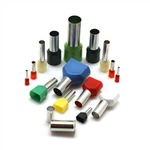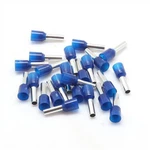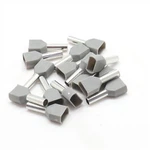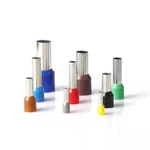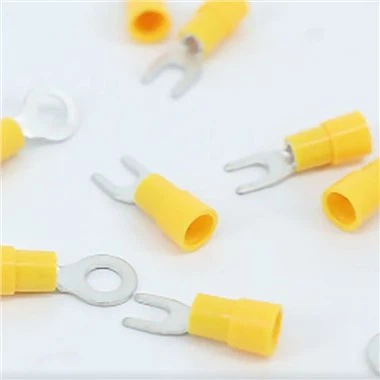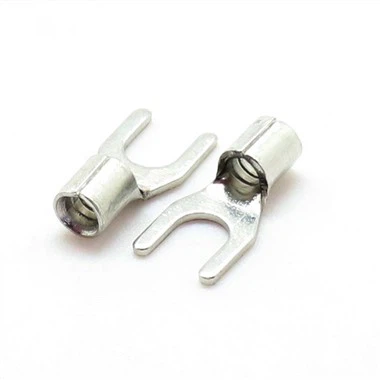Cold Press Terminals
What is Cold Press Terminals
Cold press terminals, also known as cord end terminals, electronic connectors, air joints belong to cord end terminals. Is used to achieve electrical connection of a kind of accessories products, industry divided into the category of connector.
Benefits of Cold Press Terminals
Safe and reliable
The connection method of the cold press terminals is very firm, which can effectively prevent the connection part from loosening or falling off. At the same time, the cold-pressed terminal does not require arc or flame welding, which avoids the risk of fire caused by melting and oxidation of the connecting part.
Easy to install
The installation of cold press terminals is relatively simple, and does not require professional operations like welding, so it is more convenient and quicker in terms of installation and maintenance.
Save time and cost
Since the installation of cold press terminals is relatively simple, the time and labor costs required are relatively small, so the use of cold press terminals in large-scale power projects can reduce the overall construction cost and construction period.
Why Choose us
Quality Assurance
Wenzhou baoteng always provide quality assurance to customers with strict standards and through multi-party quality system certification, such as ce, rohs, iso 9000.
Customer service
The company offers excellent customer service and support, making it easy for customers to resolve any issues they may have with the product.
Reputation
A company with a positive reputation is more likely to attract customers. Reputation is built through consistent quality service or products, good customer relations, and reliability.
When Using Cold Press Terminals, You Need To Pay Attention To These Details!
When using cold press terminals, you need to pay attention to these details! Today the editor of terminal manufacturers mainly introduces the precautions when using cold press terminals. First of all, we should be familiar with the method of operating the cold-pressed terminal. When terminating the cold-pressed terminal, we need to check strictly in accordance with the required standards before making the termination. When terminating, we must correspond to the node number and the selected cable wire. In the medium, the thickness of the large insulating layer needs to be consistent with the distance between the workpieces, and the terminal of the workpiece needs to match the core of the cable.
When soldering cold press terminals, you need to choose a suitable electric soldering iron. Then you can choose the electric soldering iron with matching power according to the diameter of the bare wire. Under normal circumstances, the actual welding time of each workpiece will not exceed five seconds. Be careful not to let the flux flow into the insulator, otherwise it will cause the insulation resistance of the workpiece to drop.
When the cooling terminal is separated, you need to take dust-proof measures for it. If the cold-pressed terminal does not separate for a long time after connection, you need to add a fuse between the socket and the plug. When the cold-pressed terminal needs to be cleaned after the operation is completed, use a silk cloth dipped in absolute ethanol to scrub the cold terminal. It is forbidden to use chemical cleaning agents such as acetone to avoid damage to the connector. You can use it after cleaning and drying.
Installation And Use Of Cold Press Terminals
Cold press terminals are a kind of electrical wiring components, which are widely used and appear in computer cases, automotive electronic systems, air-conditioning controllers and other products. Its main function is to connect fixed cables to protect the connection from moisture and dust.
Cold press terminals have good insulation properties and can effectively prevent short circuits from occurring. In addition, it also has good heat resistance, can be used in high temperature environments, and is not prone to thermal deformation. The shell of the cold-press terminal is made of high-quality thermoplastic material, which has corrosion resistance and durability, is not easy to be damaged, and can be used for a long time. It can be divided into terminal blocks and connector terminals. There are various styles of terminal blocks, which can be selected according to different usage environments. There are also various styles of connector terminals, such as plug-in type and pull-out type. First, check the quality of the terminals and wires, then place the terminals on the ground wire, insert the wires into the slots of the terminals, and then use a cold pressing tool to press the terminals to ensure the firmness of the terminals.
When installing cold press terminals, it is necessary to check the quality of the cables to ensure that the cables are not damaged to avoid short circuits. In addition, the installation process of the cold-pressed terminal is also very important. The terminal should be firmly fixed to the ground wire, and the correct cold-pressed tool should be used to press the terminal to ensure its firmness. The application field is very wide. It is often used in the wiring of electronic equipment, automotive electronic systems, air-conditioning controllers and other products. It is used to fix cables and protect the connections from moisture and dust.
The above is the relevant knowledge about cold press terminals. It has good insulation performance and heat resistance, can be used in high temperature environments, and has good corrosion resistance and durability, and is widely used. When installing cold press terminals, it is necessary to check the quality of the cables to ensure that the cables are not damaged, and to use the correct cold-pressed tools to press the terminals to ensure their firmness.
Cold-pressed terminal is a kind of connector for electrical equipment. With its characteristics and methods of use, it can be combined with the installation of cables and electrical appliances to make the operation of electrical equipment more stable and reliable. According to different needs, the types of cold press terminals will also vary. In general, cold press terminals can be divided into single-row and double-row types, and can also be divided into heat-shrinkable, riveting, hook, stop, and detachable types.
The use and installation of cold press terminals are relatively simple. As long as the above steps are followed, the use effect of cold press terminals can be guaranteed. But sometimes due to human reasons, improper installation can also cause damage to the cold press terminals, so special attention should be paid during installation.
Factors to Consider When Choosing Cold Press Terminals




1) Learn About Different Types of Cold Press Terminals and Their Uses:Based on the shape, size, and functionalities, there are various types of cold press terminals. Here are some of them.
Ring terminals: They have a ring shaped structure which is used to mount the wires and connect the circuits on the circular flat surface. These are generally used for wires of 10-22 AWG gauge.
Spade terminals: These terminals resemble a spade or fork and have pretty sharp ends which make it easy to screw the wires. You need to aware of the wire amperage required for your application before choosing the terminal.
Disconnect terminals: There are male and female disconnects which have different types of insulation materials.
Butt splice connectors: These are used to connect end wires to make the network seamless. They are also used create a new connection or fix one between two wires.
Snap Plugs: These terminals are distinguished by their round tabs that takes less space than quick-disconnect terminals with flat tabs. You can select from nylon and vinyl insulated snap plugs for your application.
Piggyback Disconnects: These disconnects are designed to make multiple connections, especially when the number of male tabs are limited.
Tap Splices/Quick Splicers: These cold press terminals are used to connect the wires of the same wire gauge. Quick splicers/tap splices can be used for an existing wire or a wire with a clean cut on the other end.
Closed End/Pigtail Connectors: The terminals are used to connect two or more wires. They feature a closed end, you can easily crimp on the wire connector to produce secured electrical connection points.
All the above mentioned types of terminals are distinguished into two types – Insulated and non-insulated. The insulated terminals feature an insulating cover, which protects the wire beneath from moisture, water, cold, and heat. This wire insulation is usually available as nylon, vinyl, and heat shrink. Among these, the heat shrink terminals are heat shrink insulated, which makes the wires and connections durable, safe, and free from corrosion and other parameters. Heat shrink terminals can be all the above types. These are commonly used in outdoor and other harsh operating environments.
2) Choose the Right Style of Male and Female Terminals: The male terminals are generally the blade side terminals, which are used to connect to T-taps, female spades, and so on. Sometimes, they can be used to replace any plug in a pinch. The female terminals are the socket side terminals, which are commonly used for connecting wires and components.
3) Use the Right Size of Terminal: Always choose the correct size cold press terminals for the application. You must match them with the size and shape of the mechanical connector, as well as the gauge/size of the wire being terminated. For instance, you might need to use an 12-10 gauge wire with the ¼ " stud-type hole.
The insulated terminals are usually identified with the color codes which depict the range of sizes. For instance, the red insulated cold press terminals may be used in sizes from 22 to 18 gauge, blue for wires from 16 to 14 gauge, yellow for wires from 12 to 10 gauge, and so on.
How To Judge The Quality Of Cold Press Terminals
Can be judged from the price, his price is lower than the market price, then needless to say.
Look at the copper material at the end of the cold press, although it can not be seen clearly at the time of purchase, but it is crucial for the socket. The easiest way to judge is to use a plug to try out whether the insertion force is moderate, and then rub it with your hand, whether the socket is really a bit heavy. You can try it with a magnet, is it a ferroalloy or iron-steel plated copper?
To see their cold-pressed end insulation materials, Insulation is very important for the safety of switch sockets, but it is difficult for ordinary consumers to judge. It is best to do a combustion test on the core components when purchasing. If there is no condition, the appearance is poor. It is very light in the hand, there is no feeling of pressure, it is easy to have scratches. Good materials generally have a relatively hard texture and are difficult to scratch. The structure is tight after molding and the weight is heavy. Good resin material, flame retardant, arc resistant, heat resistant and hard.
When you do not have the above experience, you can choose the brand or the cold-pressed end products of the brand enterpris.
How to Choose Cold Press Terminals

With the globalization of enterprises, cold press terminals need to design systems that can be sold globally, so system design employees are increasingly using power terminal block products produced in other countries. Since Europe uses a nominal value measurement method, it is common practice in Europe for equipment to be designed with a lower value than the nominal value. However, many American design employees do not understand this concept. If they do not understand the differences between various standards, they will have many difficulties in the design process.
Electronic component engineers should know that product termination skills are very important when selecting electronic components. Used to connect cold press terminals.There are many different types of pins that connect to the circuit board. Some companies only offer single-pin models, others offer multi-pin products. The advantage of multi-pin products is that it distributes the current more evenly into the circuit board traces, provides more reliable mechanical stability and improves the robustness of the soldering. This requires buyers to choose at their own discretion.
Our Factory
WENZHOU BAOTENG was established in 2013. After more than 10 years of development, it has become a comprehensive integration of industry and trade company, which engaged in design, development and production of various terminals and connectors professionally.
We have a complete research and development team, constantly developing more and more designs every year.
Quality is our culture, service is our standard, we have been holding this philosophy to provide customers with quality products. WENZHOU BAOTENG always provide quality assurance to customers with strict standards and through multi-party quality system certification, such as CE, ROHS, ISO 9000.
WENZHOU BAOTENG is engaged in the supply of electrical products with the quality of "Safe, Reliable, Suitable and Steady", observes the commitment of "Leader in science and technology, Honest operation, Quality and Customer first", provides highest quality and the most sincere services for the new and old, domestic and foreign customers.


